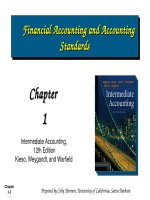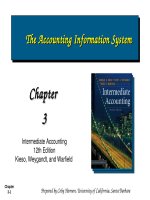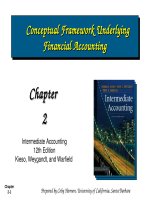Lecture Intermediate Accounting (13th edition) - Chapter 5: Balance sheet and statement of cash flows
Bạn đang xem bản rút gọn của tài liệu. Xem và tải ngay bản đầy đủ của tài liệu tại đây (2.32 MB, 72 trang )
Chapter
5-1
CHAPTER
5
BALANCE SHEET AND
STATEMENT OF CASH FLOWS
Intermediate Accounting
13th Edition
Kieso, Weygandt, and Warfield
Chapter
5-2
Learning Objectives
Learning Objectives
1.
Explain the uses and limitations of a balance sheet.
2.
Identify the major classifications of the balance sheet.
3.
Prepare a classified balance sheet using the report and account formats.
4.
Determine which balance sheet information requires supplemental disclosure.
5.
Describe the major disclosure techniques for the balance sheet.
6.
Indicate the purpose of the statement of cash flows.
7.
Identify the content of the statement of cash flows.
8.
Prepare a statement of cash flows.
9.
Understand the usefulness of the statement of cash flows.
Chapter
5-3
Balance Sheet and Statement of Cash Flows
Balance Sheet and Statement of Cash Flows
Balance Sheet
Usefulness
Purpose
Limitations
Content and format
Classification
Preparation
Additional information
reported
Usefulness
Techniques of
disclosure
Chapter
5-4
Statement of Cash
Flows
Balance Sheet
Balance Sheet
Usefulness of the Balance Sheet
Evaluating the capital structure.
Assess risk and future cash flows.
Analyze the company’s:
Chapter
5-5
Liquidity,
Solvency, and
Financial flexibility.
LO 1 Explain the uses and limitations of a balance sheet.
Balance Sheet
Balance Sheet
Limitations of the Balance Sheet
Most assets and liabilities are reported at historical cost.
Use of judgments and estimates.
Many items of financial value are omitted.
Chapter
5-6
LO 1 Explain the uses and limitations of a balance sheet.
Balance Sheet
Balance Sheet
Classification in the Balance Sheet
Three General Classifications
Assets, Liabilities, and Stockholders’ Equity
Companies further divide these classifications:
Illustration 51
Chapter
5-7
LO 2 Identify the major classifications of the balance sheet.
Balance Sheet
Balance Sheet
Current Assets
Cash and other assets a company expects to convert into cash, sell, or
consume either in one year or in the operating cycle, whichever is
longer.
Illustration 52
Chapter
5-8
LO 2 Identify the major classifications of the balance sheet.
Balance Sheet
Balance Sheet
Review
The correct order to present current assets is
a.
Cash, accounts receivable, prepaid items,
b.
Cash, accounts receivable, inventories, prepaid
items.
c.
Cash, inventories, accounts receivable, prepaid
items.
d.
Cash, inventories, prepaid items, accounts receivable.
Chapter
5-9
inventories.
LO 2 Identify the major classifications of the balance sheet.
Balance Sheet – “Current Assets”
Balance Sheet – “Current Assets”
Cash
Generally any monies available “on demand.”
Cash equivalents shortterm highly liquid investments that mature
within three months or less.
Restrictions or commitments must be disclosed.
Illustration 53
Chapter
5-10
LO 2 Identify the major classifications of the balance sheet.
Balance Sheet – “Current Assets”
Balance Sheet – “Current Assets”
ShortTerm Investments
Portfolios
Type
Valuation
Classification
HeldtoMaturity
Debt
Amortized Cost
Current or
Noncurrent
Trading
Debt or Equity
Fair Value
Current
Available forSale
Debt or Equity
Fair Value
Current or
Noncurrent
Chapter
5-11
LO 2 Identify the major classifications of the balance sheet.
Balance Sheet – “Current Assets”
Balance Sheet – “Current Assets”
ShortTerm Investments
Chapter
5-12
Illustration 55
Balance Sheet Presentation
of Investments in Securities
LO 2 Identify the major classifications of the balance sheet.
Balance Sheet – “Current Assets”
Balance Sheet – “Current Assets”
Receivables
Claims held against customers and others for money, goods, or services.
Accounts receivable – oral promises
Notes receivable – written promises
Major categories of receivables should be shown in the balance sheet or the
related notes.
Chapter
5-13
LO 2 Identify the major classifications of the balance sheet.
Balance Sheet – “Current Assets”
Balance Sheet – “Current Assets”
Accounts Receivable – Presentation Options
11
22
Chapter
5-14
Current Assets:
Cash
Accounts receivable
Less allowance for doubtful accounts
Inventory
Total current assets
Current Assets:
Cash
Accounts receivable, net of $25 allowance
Inventory
Total current assets
$ 346
500
25
475
812
$1,633
$ 346
475
812
$1,633
LO 2 Identify the major classifications of the balance sheet.
Balance Sheet – “Current Assets”
Balance Sheet – “Current Assets”
Receivables
Illustration 56
Balance Sheet Presentation
of Receivables
Chapter
5-15
LO 2 Identify the major classifications of the balance sheet.
Balance Sheet – “Current Assets”
Balance Sheet – “Current Assets”
Inventories
Company discloses:
Basis of valuation (e.g., lowerofcostormarket).
Method of pricing (e.g., FIFO or LIFO).
Illustration 57
Chapter
5-16
LO 2 Identify the major classifications of the balance sheet.
Balance Sheet – “Current Assets”
Balance Sheet – “Current Assets”
Prepaid Expenses
Payment of cash, that is recorded as an asset because service or benefit
will be received in the future.
Cash Payment
BEFORE
Expense Recorded
Prepayments often occur in regard to:
insurance
supplies
advertising
Chapter
5-17
rent
maintenance on equipment
LO 2 Identify the major classifications of the balance sheet.
Balance Sheet – “Current Assets”
Balance Sheet – “Current Assets”
Prepaid Expenses
Illustration 59
Chapter
5-18
LO 2 Identify the major classifications of the balance sheet.
Balance Sheet – “Current Assets”
Balance Sheet – “Current Assets”
Current Assets “Summary”
Cash and other assets a
company expects to
convert into cash,
sell, or
consume
either in one year or in the
operating cycle, whichever is
longer.
Chapter
5-19
Ba la nc e S h e e t ( in tho us a nd s )
C ur r e nt a s s e t s
Ca s h
S T I nve s tm e nts
Ac c o unt s r e c e iva b le
I nve nto r y
Pr e pa id e x pe ns e s
T o ta l c ur r e nt a s s e t s
I nve s t m e nt s :
I nve s m e nt in ABC b o nd s
I nve s tm e nt in UC I nc .
$ 2 8 5 ,0 0 0
14 0 ,0 0 0
7 7 7 ,0 0 0
4 0 2 ,0 0 0
17 0 ,0 0 0
1,7 7 4 ,0 0 0
3 2 1,6 5 7
2 5 3 ,9 8 0
LO 2 Identify the major classifications of the balance sheet.
Balance Sheet – “Noncurrent Assets”
Balance Sheet – “Noncurrent Assets”
LongTerm Investments
Generally consists of four types:
Securities
Securities
Fixed assets
Special funds
Nonconsolidated subsidiaries or affiliated companies.
Nonconsolidated subsidiaries
Chapter
5-20
LO 2 Identify the major classifications of the balance sheet.
Balance Sheet – “Noncurrent Assets”
Balance Sheet – “Noncurrent Assets”
LongTerm
Investments
Securities
Securities
bonds,
stock, and
longterm notes
For marketable securities,
management’s intent determines
current or noncurrent classification.
Chapter
5-21
Ba la nc e S h e e t (in t h o us a nd s )
Cur r e nt a s s e t s
Ca s h
$ 2 8 5 ,0 0 0
I nve s t m e nt s :
I nve s m e nt in A BC b o nd s
I nve s t m e nt in UC I nc .
No t e s r e c e iva b le
La nd h e ld f o r s pe c ula t io n
S ink ing f und
Pe ns io n f und
Ca s h s ur r e nd e r va lue
I nve s t m e nt in Unc o n. S ub .
T o t a l inve s t m e nt s
Pr o pe r t y , Pla nt , a nd Eq uip.
Build ing
La nd
3 2 1,6 5 7
2 5 3 ,9 8 0
15 0 ,0 0 0
5 5 0 ,0 0 0
2 2 5 ,0 0 0
6 5 3 ,7 9 8
8 4 ,3 2 1
4 5 7 ,8 3 6
2 ,6 9 6 ,5 9 2
1,3 7 5 ,7 7 8
9 7 5 ,0 0 0
LO 2 Identify the major classifications of the balance sheet.
Balance Sheet – “Noncurrent Assets”
Balance Sheet – “Noncurrent Assets”
LongTerm
Investments
Ba la nc e S h e e t (in t h o us a nd s )
Cur r e nt a s s e t s
Ca s h
$ 2 8 5 ,0 0 0
I nve s t m e nt s :
Fixed Assets
Fixed Assets
Land held for
speculation
I nve s m e nt in A BC b o nd s
I nve s t m e nt in UC I nc .
No t e s r e c e iva b le
La nd h e ld f o r s pe c ula t io n
S ink ing f und
Pe ns io n f und
Ca s h s ur r e nd e r va lue
I nve s t m e nt in Unc o n. S ub .
T o t a l inve s t m e nt s
Pr o pe r t y , Pla nt , a nd Eq uip.
Build ing
La nd
Chapter
5-22
3 2 1,6 5 7
2 5 3 ,9 8 0
15 0 ,0 0 0
5 5 0 ,0 0 0
2 2 5 ,0 0 0
6 5 3 ,7 9 8
8 4 ,3 2 1
4 5 7 ,8 3 6
2 ,6 9 6 ,5 9 2
1,3 7 5 ,7 7 8
9 7 5 ,0 0 0
LO 2 Identify the major classifications of the balance sheet.
Balance Sheet – “Noncurrent Assets”
Balance Sheet – “Noncurrent Assets”
LongTerm
Investments
Ba la nc e S h e e t (in t h o us a nd s )
Cur r e nt a s s e t s
Ca s h
$ 2 8 5 ,0 0 0
I nve s t m e nt s :
Special Funds
Special Funds
Sinking fund
Pensions fund
Cash surrender value
of life insurance
I nve s m e nt in A BC b o nd s
I nve s t m e nt in UC I nc .
No t e s r e c e iva b le
La nd h e ld f o r s pe c ula t io n
S ink ing f und
Pe ns io n f und
Ca s h s ur r e nd e r va lue
I nve s t m e nt in Unc o n. S ub .
T o t a l inve s t m e nt s
Pr o pe r t y , Pla nt , a nd Eq uip.
Build ing
La nd
Chapter
5-23
3 2 1,6 5 7
2 5 3 ,9 8 0
15 0 ,0 0 0
5 5 0 ,0 0 0
2 2 5 ,0 0 0
6 5 3 ,7 9 8
8 4 ,3 2 1
4 5 7 ,8 3 6
2 ,6 9 6 ,5 9 2
1,3 7 5 ,7 7 8
9 7 5 ,0 0 0
LO 2 Identify the major classifications of the balance sheet.
Balance Sheet – “Noncurrent Assets”
Balance Sheet – “Noncurrent Assets”
LongTerm
Investments
Ba la nc e S h e e t (in t h o us a nd s )
Cur r e nt a s s e t s
Ca s h
$ 2 8 5 ,0 0 0
I nve s t m e nt s :
Nonconsolidated
Nonconsolidated
Subsidiaries or
Subsidiaries or
Affiliated
Affiliated
Companies
Companies
Chapter
5-24
I nve s m e nt in A BC b o nd s
I nve s t m e nt in UC I nc .
No t e s r e c e iva b le
La nd h e ld f o r s pe c ula t io n
S ink ing f und
Pe ns io n f und
Ca s h s ur r e nd e r va lue
I nve s t m e nt in Unc o n. S ub .
T o t a l inve s t m e nt s
Pr o pe r t y , Pla nt , a nd Eq uip.
Build ing
La nd
3 2 1,6 5 7
2 5 3 ,9 8 0
15 0 ,0 0 0
5 5 0 ,0 0 0
2 2 5 ,0 0 0
6 5 3 ,7 9 8
8 4 ,3 2 1
4 5 7 ,8 3 6
2 ,6 9 6 ,5 9 2
1,3 7 5 ,7 7 8
9 7 5 ,0 0 0
LO 2 Identify the major classifications of the balance sheet.
Balance Sheet – “Noncurrent Assets”
Balance Sheet – “Noncurrent Assets”
Property, Plant, and
Equipment
Assets of a durable
nature used in the
regular operations of the
business.
Ba la nc e S h e e t (in t h o us a nd s )
Cur r e nt a s s e t s
Ca s h
T o t a l inve s t m e nt s
2 ,6 9 6 ,5 9 2
Pr o pe r t y , Pla nt , a nd Eq uip.
Build ing
La nd
Ma c h ine r y a nd e q uipm e nt
Ca pit a l le a s e s
Le a s e h o ld im pr o ve m e nt s
A c c um ula t e d d e pr e c iat io n
T o t a l PP&E
I nt a ng ib le s
Go o d will
Pa t e nt s
T r ad e m a r k s
Chapter
5-25
$ 2 8 5 ,0 0 0
1,3 7 5 ,7 7 8
9 7 5 ,0 0 0
2 3 4 ,9 5 8
3 8 4 ,6 5 0
17 5 ,0 0 0
(9 7 5 ,0 0 0 )
2 ,17 0 ,3 8 6
3 ,0 0 0 ,0 0 0
17 7 ,0 0 0
4 0 ,0 0 0
LO 2 Identify the major classifications of the balance sheet.









